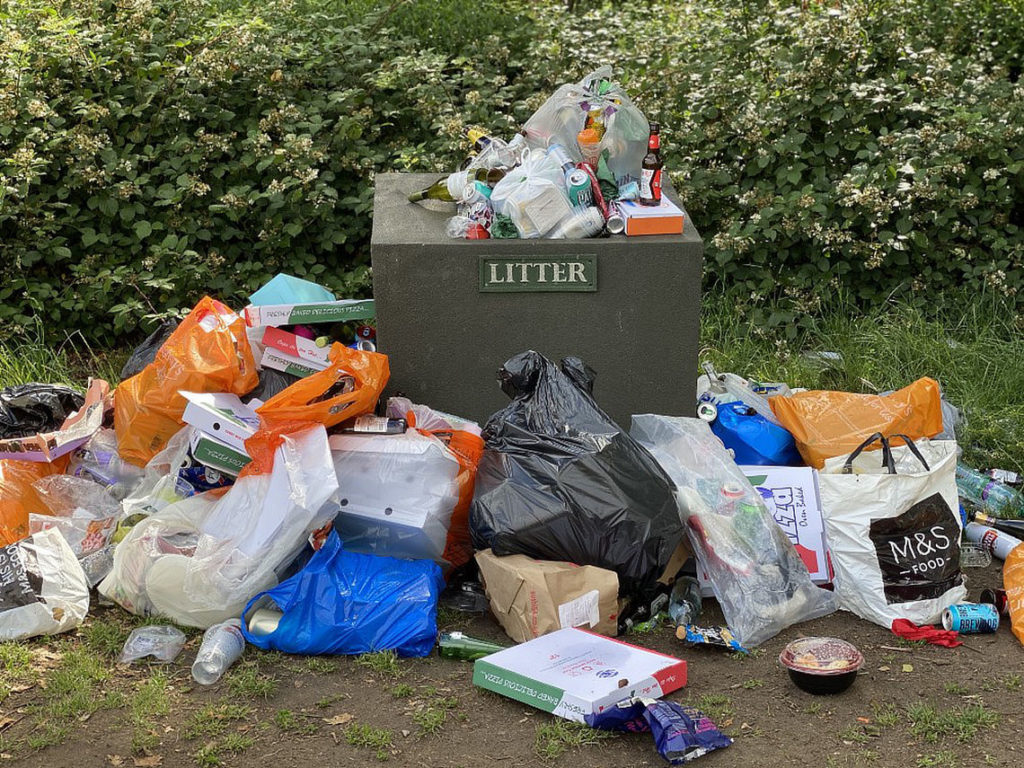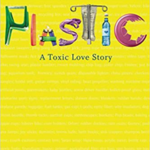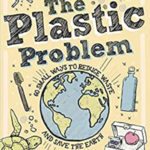Choose to be part of the solution, not the pollution

Plastics, once viewed as a miraculous product, are now proving to be a huge environmental problem.
It has taken a long time for many of us to believe that the ever-so-convenient plastic:
- Tupperware;
- storage boxes;
- children’s toys;
- bodies of most domestic machinery;
- plastic wrap;
- cooking utensils;
- plastic plates;
- the computer I am currently working on,
are now seen as out-of-control, environmental hazards.
And yet, to imagine a world without this durable material is almost impossible! Arriving by stealth, it has become a fundamentally convenient part of everyday living.
The notion of reverting to wrapping lunches in paper, just doesn’t stack up against it any more.
And how much crockery would we have to replace were our children to eat from china plates? Whether you can afford the perpetual renewal of china is irrelevant, because the convenience of plastic wins hands down.
At the completion of this article, I have listed the 5 practical ways that I personally follow to reign in on this plastic explosion. They are simple and achievable. You can jump there right now, but I urge you to read the article to understand their context.
What price are we be paying for this convenience?
Is our reliance on plastic going to come back and bite us where it hurts most? Or is it already biting?
Our homes are awash with the stuff:
- veneers for furniture;
- protection for wooden floors;
- shower gel;
- power sockets;
- kitchen appliances; and
- light fittings.
This is just a list I am making, as I look around the room I am working in right now, but we all know that there is so much more.
In fact, it’s frighteningly longer, such that we have almost painted ourselves into a corner in our reliance on this product, and in turning it around.
 In her book, Plastic – A Toxic Love Story, Susan Freinkel talks about her decision to spend one day, just one, without touching anything made of plastic. But wherever she turned, everything seemed to have a plastic base – light switches, kitchen benches, toilet seats; and that didn’t make her day!
In her book, Plastic – A Toxic Love Story, Susan Freinkel talks about her decision to spend one day, just one, without touching anything made of plastic. But wherever she turned, everything seemed to have a plastic base – light switches, kitchen benches, toilet seats; and that didn’t make her day!
It was clear that the experiment would have to have a different focus, and so instead, she looked at how many she touched.
The number was high.
So can we ever do without it?
It all seems too hard, doesn’t it…and yet, the crisis is looming and a solution must be found.
But not all plastics are created equal
Some are used time and time again, and as such, we can almost justify their usage.
On the other hand, what about the once-only plastics? Today I am going to focus on just a few.
Coffee Pods
Close to three million are used, and tossed, each and every day.
If we are looking at little more than their amazing popularity, then it’s a business model that has worked well, and has raked in a tidy sum for those companies pandering to our caffeine addiction.
But here’s the rub. The original inventor of the pods, John Sylvan, has come out publicly and admitted that he regrets his invention. He freely admits the pods are an environmental disaster. They are neither recyclable nor biodegradable, resulting because of the four-layered plastic that makes up their composition.
It’s enough to make you rethink your coffee habit, isn’t it!
And then, the ubiquitous plastic bags
They’re everywhere and until recently, we used them with little concern for their environmental impact.
Statistically, we use five trillion every year.
Every second, 160,000 bags are produced, which equates to an annual usage of 700 per person.
“While some plastics are lucky enough to be recycled, most are sent to landfill, and the rest is left to its own devices, free to roam our environment, clogging up streams, rivers, lakes and oceans, polluting forests and soils. There is even a new term for it: ‘white pollution’”.
I am now no longer part of that statistic. So, no more plastic bags for me. It’s an easy decision for buying. We can always port our own bags to do our shopping, but what about disposing of refuse?
In some parts of New South Wales, Australia, local governments have really stepped up to the plate and introduced the recycling of all food scraps, dog poo, and anything else that is organic. It’s wonderful.
Even the liner bags of the bins provided are compostable, so they are popped in too. But the best part is that each year, people involved can collect two bags of organic compost, for free. Now that is a great incentive!
So, we could feel a little virtuous about the plastic bag problem, but there are other plastics that we aren’t necessarily aware of, including:
Our Wardrobes
There has never been a time in history when clothes have been so affordable, or when we have spent so enthusiastically on them. It’s that very affordability that means we buy with little thought.
Most have a plastic base, and it is that very plastic that threatens our food supply.
Professor Sherri Mason, a professor of chemistry and a researcher from the State University of New York, was shocked when she cut open a Great Lakes fish and found synthetic fibres ‘weaving themselves into the gastrointestinal tract’.
Think about that! It means that, by default, we could be eating our own clothes!
Professor Mason is also the scientist who discovered the dangers of micro-plastics ‘our smallest category of plastics that are categorized as micro-plastics, plastics that have a diameter from 1/3 mm up to 1 mm’.
These are linked to cosmetics, such as exfoliating facial scrubs.
Facial Scrubs
‘Micro-plastic pollution comes from the fragmentation of larger pieces of plastic waste, small synthetic fibres from clothing, and the micro-beads used in cosmetics and other products. The micro-beads in scrubs, shower gels and toothpaste are potentially an avoidable part of this plastic pollution problem. A single shower could result in 100,000 plastic particles entering the ocean’, said the committee chair.
Synthetic clothes harm our food supply
For a long and challenging time, ecologist Mark Browne had been intently studying sediment along the world’s shorelines, when he began to notice something that intrigued him. These were fibres that seemed to be at their most abundant around sewage outlets.
Our laundries are the source!
Through the clothing we wear, we are now much to blame for the proliferation of the microscopic threads which, because they are too tiny to be filtered out at wastewater plants, are sent out to sea and get caught up in the five ocean gyres (currents). Numerous studies have shown that small organisms readily ingest microplastics, introducing toxic pollutants to the food chain.
This is: “…the biggest environmental problem you’ve never heard of’.
By sampling wastewater from domestic washing machines, Browne estimated that around 1,900 individual fibres can be rinsed off a single synthetic garment — ending up in our oceans”.
Browne contacted many clothing companies, in an effort to have them change their practice. None of the better-brand names was interested in cooperating with him.
And there is part of the problem. If manufacturers are purely profit-driven, it will be difficult to turn this issue around.
Now the fact is we can all sit back, safe in the knowledge that it’s all too hard for us mere mortals, and let the experts sort out our futures, or, we can do something about it ourselves.
‘We ourselves feel that what we are doing is just a drop in the ocean. But the ocean would be less because of that missing drop’.
The truth is that we can be the catalyst for change.
Sure, synthetics will be with us for a while longer. They’re affordable, often stylish, and they last. History tells us that affordability is always going to win over conscience.
So instead, let’s see if, by our actions, we can reduce the environmental impact of our choices.
Why not employ the same standards for washing your synthetic clothes as for say, an expensive wool sweater?
We don’t wash wool every time we wear it. Wool is expensive and demands care.
So treat most of your clothes as you would, wool. Don’t wash things so often. With a little ecological thinking, we can transport ourselves to the days of yore and survive.
Take the exercise outfits that we tend to wash more often than is necessary. Why can’t we get seven days’ wear from them before washing them?
If you’re playing the sport for an hour or so each day, and if you wear your outfit seven times, that still only equates to less than a workday’s wear.
I hear your protest, BUT, before you get too disgusted, we are trying to do our bit to save the planet, are we not?
The other bonus in washing less, is that you will be using far less washing powder, (I have already cut back on that and my clothes come out clean!). Besides:
‘Microbeads are designed to last a long time in products and are similarly persistent in the sea. They look like the eggs of small fish or tiny planktonic organisms and so, are taken up by filter-feeding creatures such as krill, shrimps, crabs, lugworms, oysters and small fish.
‘Among these and other animals, microbeads can cause gut blockage, altered feeding behaviour and reduced energy allocation, resulting in impacts on growth and reproduction. Smaller animals are in turn eaten by bigger ones — including fish, birds and marine mammals — and, as the microbeads and their attendant toxins travel up through food webs, the poisons become more concentrated, including in the fish that people eat. So it is that some of what we wash down the sink comes back, and in the process brings a toxic cargo with it’.
So what exactly am I advocating here?
- Be aware of the impact you are having on the environment in the frequent washing of your clothes
- Think about your comfort habits that have huge ramifications through the food chain
- CARE! Refuse to buy! Manufacturers will notice and adjust to your modelling.
- Buy fewer clothes, and instead get creative.
And cosmetics?
Journalist Jimmy Leach has worrying statistics that challenge us to rethink our beauty regime.
‘The European Commission estimates that each year, Europe releases nearly 9,000 tonnes of cosmetic microbeads into the ocean, although the total quantity is bigger than this. For example, industry association Cosmetics Europe doesn’t recognize plastic particles smaller than 0.001mm as microbeads, and so doesn’t include these in their official statistics.
‘One bottle of sunscreen can contain as many as 10 trillion of these plastic nanoparticles and, considering the vast quantity of such products sold each year, the tonnage of microbeads entering the marine environment from personal care products is very likely higher than generally estimated.
‘Maybe, at the very least, we could discard the ones that contain microplastics such as the polyethene (PE), polypropylenes (PP), and the terephthalates (PET).’
If a growing number of us leaves them on the shelf, they’ll soon get the message.
It’s up to us!
We either care, or we don’t. There are no half measures. That is not to say that we throw the baby out with the bathwater. What it does challenge us to do is play some small part in being the change we want to see.
Based on all of the above, here are 5 practical steps that I have adopted.
- I don’t use plastic bags for shopping, but is that enough? The answer is clearly no, and I continually seek ways not to use them. I shop at markets for most of my food and take-along containers, and a shopping trolley.
- I seriously consider my wardrobe — putting time between my want and purchase, has been the best decision I have made. Not shopping for one whole year was even better. Staying away from temptation? Even better still!
- I’m trying to buy all-natural clothing, but again, it’s not always possible. What is ABSOLUTELY possible is buying far fewer clothes. I’m committed to that!
- I’m paring down the number of cosmetics I use though, to be honest, I was never vested in them.
- I’ve researched widely on sunscreen and have concluded that sensible sun exposure is the way to go. Studies have shown that the risks of vitamin D deficiency are greater in people who slather on sun protection.
This is a serious call to action
Don’t discount your involvement. You matter. Be assured every little change that any of us makes, will have a ripple effect.
Your decisions may not seem much to you personally, but imagine the tsunami of relief on our planet, if many, many more were to get on board.
Proven, practical ideas you can work on Right Now...
 Get started today. With The Plastic Problem, you (and your kids) will discover loads of brilliant and easy ways to cut plastic out of your life!
Get started today. With The Plastic Problem, you (and your kids) will discover loads of brilliant and easy ways to cut plastic out of your life!
⭐⭐⭐⭐⭐This five-star rated treasure chest means you’ll all be feeling worthy straight away.






